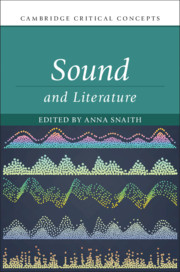Book contents
- Sound and Literature
- Cambridge Critical Concepts
- Sound and Literature
- Copyright page
- Epigraph
- Contents
- Figures
- Contributors
- Acknowledgements
- Introduction
- Part I Origins
- Part II Development
- Part III Applications
- Chapter 10 What We Talk about When We Talk about Talking Books
- Chapter 11 Prose Sense and Its Soundings
- Chapter 12 Dissonant Prosody
- Chapter 13 Deafness and Sound
- Chapter 14 Vibrations
- Chapter 15 Feminism and Sound
- Chapter 16 Wireless Imaginations
- Chapter 17 Attending to Theatre Sound Studies and Complicité’s The Encounter
- Chapter 18 Bob Dylan and Sound: A Tale of the Recording Era
- Bibliography
- Index
Chapter 16 - Wireless Imaginations
from Part III - Applications
Published online by Cambridge University Press: 29 May 2020
- Sound and Literature
- Cambridge Critical Concepts
- Sound and Literature
- Copyright page
- Epigraph
- Contents
- Figures
- Contributors
- Acknowledgements
- Introduction
- Part I Origins
- Part II Development
- Part III Applications
- Chapter 10 What We Talk about When We Talk about Talking Books
- Chapter 11 Prose Sense and Its Soundings
- Chapter 12 Dissonant Prosody
- Chapter 13 Deafness and Sound
- Chapter 14 Vibrations
- Chapter 15 Feminism and Sound
- Chapter 16 Wireless Imaginations
- Chapter 17 Attending to Theatre Sound Studies and Complicité’s The Encounter
- Chapter 18 Bob Dylan and Sound: A Tale of the Recording Era
- Bibliography
- Index
Summary
The future development of literary radio studies as a discipline requires moving beyond the lingering (and completely understandable) text-fetishism of its early years. Archival lacunae covering the early years of radio, key years for modernist production – the difficulty of hearing works, let alone hearing them in context – has paradoxically flattened broadcast into script, an elision often perpetuated in scholarship. All this has created a critical environment in which the claim that radio is an intrinsically modernist medium is often supported, in circular fashion, by enumerating the already-recognized modernists within broadcast ranks, or citing the importance of radio as a disseminator of modernist poetry – in other words, eliding the medium itself in order to stress its efficacy as a delivery system. To move beyond the invaluable spadework of the recent ‘boom’, then, requires a more robust methodology for tracing the resonances of radio – an intermedial vocabulary not grounded exclusively in inscription
- Type
- Chapter
- Information
- Sound and Literature , pp. 334 - 350Publisher: Cambridge University PressPrint publication year: 2020
- 3
- Cited by

